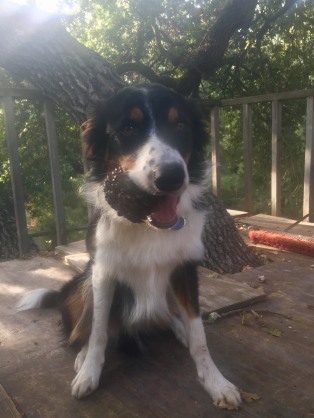
In California AKC Novice is usually during the hottest part of the day. USDAA Starters can be running at any time, but often happens after lunch. It’s not just novice dogs who need to be used to the heat though, USDAA Grand Prix Finals are usually held in the early afternoon.
Unless you wish to give your dog a nasty surprise for their first Novice runs or Grand Prix Finals, it is best to make it very rewarding for them to do a little bit of agility (no overdoing things, agility runs only take seconds) in the heat of the day.
Imagine a dog that is used to a group class in the evening experiencing their first agility run and their first warm rubber contact obstacle (surprise! no rewards in the ring) at a time of day when they are very used to napping.
This is why, in fairness to my dogs, some of my infrequent training sessions are a quick trip outside to reward a contact obstacle in the warmer part of the day.
I am currently teaching my English Shepherd puppy, Kelsa, (14 months) to love the seesaw. She really enjoys jumping on the end and getting treats from the cookie machine (Treat and Train). It was pretty cool early this morning, but by 10 am I realized that the weather had changed and it was already a wee bit too hot out there. She was keen to get started, but I decided to have her wait in the shade while I felt the rubber contact on the seesaw. I am so glad I did as it was too hot for my dog to comfortably hold a position with two rear feet on.
She was willing and able, but as the entire point is to generate a good first impression I decided to have her remain in the shade while I had a think. I did explain what was going on and she was quite cool with the idea.
It is always good to have a think about what you are asking a willing dog to do because it is only fair and it also makes your training so much quicker and easier! If in doubt about anything do stop and think and if you can’t think of a good reason to do it, then don’t.
This morning was a big eye-opener about the impressions our inexperienced dogs get from our seemingly ridiculous desire to ask them to run over rubber in the middle of the day. While I was thinking I decided to get a towel and place it over the rubber down contact on the seesaw and see how much difference that made.
After a few minutes I tested it and it was considerably cooler and Kelsa was still keen to have a go at playing with the seesaw and the cookie machine so I let her do a couple of repetitions and then came back inside.
So if you have running contacts expect your dog to run faster in the heat and if you have stopped contacts realize that your dog may have a good reason for not wanting to hang around.








